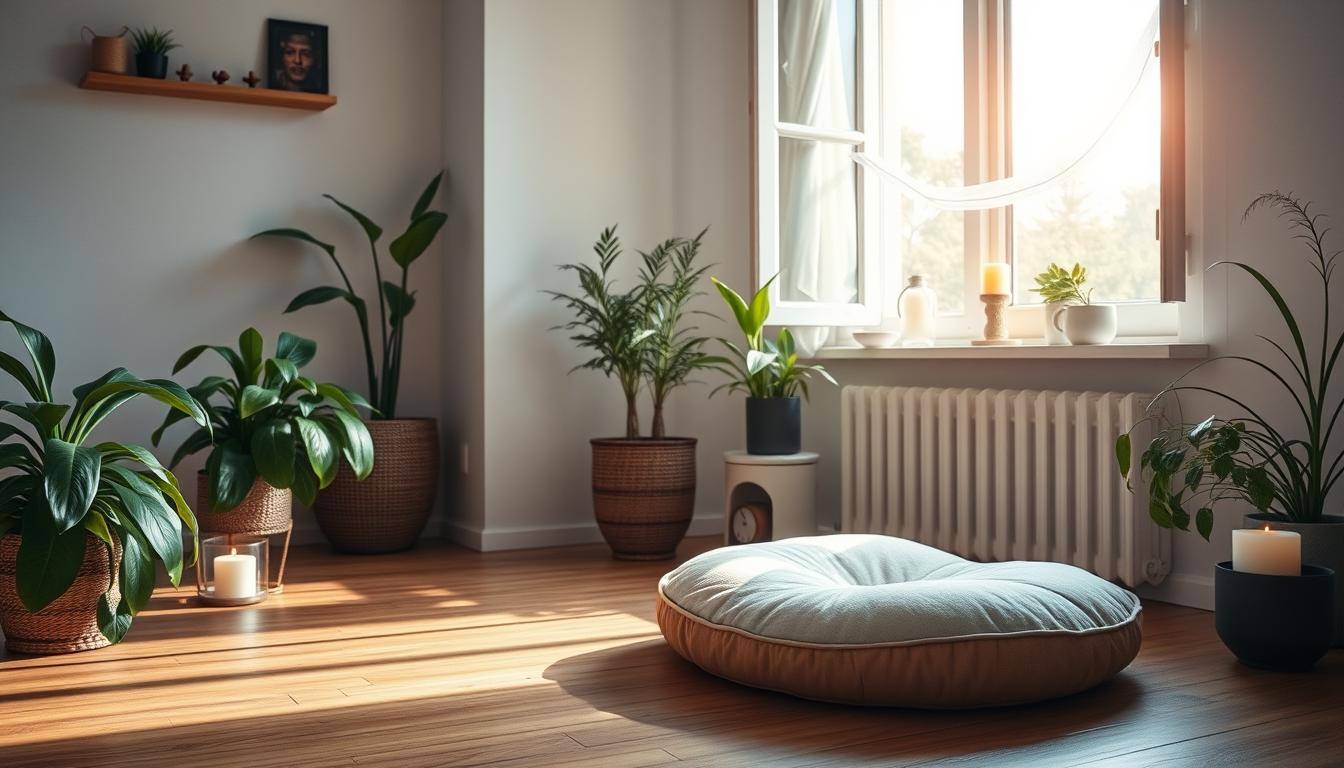“The present moment is the only moment available to us, and it is the door to all moments.” – Thich Nhat Hanh
Mindfulness meditation can change your life. It helps you stay in the present, lowers stress, and boosts focus. This article will show you how to start at home. You’ll learn the basics, set up your space, and find ways to stay focused.
With regular practice, you’ll see the benefits of mindfulness. It will become a part of your daily life.
Key Takeaways
- Mindfulness meditation can physically reshape the brain’s structure and promote awareness.
- Practicing mindfulness can reduce stress, anxiety, and negative emotions, while fostering a kinder, calmer, and more patient state of mind.
- Consistent meditation practice, even as little as 12 minutes per day, can strengthen attention and focus.
- Mindfulness meditation can enhance emotional health, improve sleep quality, and boost the immune system.
- Establishing a regular meditation routine takes time, but the benefits continue to emerge over time.
Understanding Mindfulness Meditation
What is Meditation?
Meditation is a way to calm your mind and focus on the present. It helps you become more aware and mindful. You learn to concentrate by focusing on your breath.
Benefits of Mindfulness Meditation
Meditation brings many benefits to your life. It helps you understand and deal with pain better. It also lowers stress levels and makes you feel more relaxed.
It boosts your mindfulness and empathy. This makes your relationships stronger and communication better. You start to feel more connected to others.
Meditation improves your ability to focus and stay productive. It quiets your mind, leading to a clearer, more peaceful mind. It also makes you more positive and balanced.
“Meditation is the dissolution of thoughts in Eternal awareness or Pure consciousness without objectification, knowing without thinking, merging finitude in infinity.” – Voltaire
Studies show that mindfulness exercises outdoors are especially good. You can do simple exercises anywhere, anytime. But, more structured ones like body scan or sitting meditation need a quiet spot.
Many clinical trials have looked into meditation’s effects. It’s proven to help with stress, anxiety, pain, depression, insomnia, high blood pressure, asthma, and fibromyalgia.
Getting Started with Mindfulness Meditation
Setting Up Your Practice Space
To start your mindfulness meditation at home, create a calm and comfy space. It could be a corner with a cushion or chair. Make sure it’s quiet and free from distractions.
Adding candles, incense, or calming art can help you focus. These elements make your meditation space feel more grounding.
Finding the Right Posture
Finding the right posture is key for comfort and focus. You can sit in a chair or cross-legged on a cushion. The goal is to be stable yet relaxed.
Avoid lying down to prevent falling asleep. Try different positions to find what works best for you.
Start with 5-20 minutes of practice, beginning with short sessions. Practice mindful meditation regularly to see the most benefits. Make it a part of your daily routine, like in the morning or evening.
“Mindfulness is not a performance and does not have a graded outcome. The goal is to be present, not to be good at it.”
Breath Awareness Meditation
Mindfulness meditation is a popular technique. Breath awareness is a key part of it. You focus on the breath moving in and out of your body.
By following your breath, you stay in the present moment. This helps you feel calm and clear. When your mind drifts, bring it back to your breath.
This simple practice is perfect for beginners. Studies show it can calm your nervous system. It helps move your body from stress mode to rest mode.
To start, sit comfortably. You can sit on the floor or in a chair. Close your eyes or look down softly.
Notice how your breath feels. Feel your belly rise and fall. Notice the cool air as you breathe in and the warmth as you breathe out.
- Inhale deeply through your nose, feeling your belly expand.
- Exhale slowly through your mouth, allowing your belly to deflate.
- Repeat this cycle, focusing on your breath.
If your mind wanders, gently bring it back to your breath. Regular practice can bring more presence, peace, and clarity into your life.

“The breath is the bridge which connects life to consciousness, which unites your body to your thoughts. Whenever your mind becomes scattered, use your breath as the means to take hold of your mind again.”
– Thich Nhat Hanh
| Technique | Benefits | Research |
|---|---|---|
| Breath Awareness Meditation | – Reduces stress and anxiety – Improves focus and concentration – Enhances emotional regulation |
– Helps shift the body from sympathetic to parasympathetic nervous system – Reduces blood pressure and improves heart rate – Effective in managing conditions like asthma and COPD |
Dealing with Wandering Thoughts
It’s normal to have wandering thoughts during meditation, even for experts. The trick is to learn how to gently refocus your mind. This way, you can stay present and become more mindful and emotionally strong.
By practicing, you can improve your ability to stay present during meditation. This will help you grow in mindfulness and emotional strength.
Techniques for Refocusing
Don’t worry if your mind wanders. Instead, use these easy tips to refocus your meditation:
- Gently bring your attention back to your breath, observing the natural flow of inhalation and exhalation.
- Label the thoughts as they arise, noting them as “planning,” “remembering,” or simply “thinking.”
- Visualize your thoughts as clouds drifting across the sky, allowing them to pass without getting caught up in them.
- If a particular thought persists, try writing it down in a journal after your meditation session to address it later.
With time and practice, you’ll get better at noticing when your mind wanders. You’ll also learn to guide it back to the present moment. This skill is key to staying present during meditation and finding inner peace.
“The art of meditation is the art of paying attention.” – Sharon Salzberg
easy steps to practice mindfulness meditation at home for beginners
Starting your mindfulness meditation journey at home can change your life. Just a few simple steps can help you enjoy its deep benefits. You’ll feel more aware, focused, and peaceful every day. [https://affirmnosis.com/elevate-your-life-with-mindfulness-meditation-techniques/]
- Find a Quiet Space: Pick a quiet spot in your home for a few minutes. It could be a corner of your living room or your bedroom.
- Sit in a Stable Posture: Sit up straight but comfortably. This helps you stay alert and focused.
- Focus on Your Breath: Start by focusing on your breath. Feel the air move in and out. If your mind drifts, bring it back to your breath.
Start with 5-10 minutes each session and grow from there. Be patient and kind to yourself. With regular practice, you’ll see mindfulness meditation’s benefits in your life.
| Mindfulness Meditation Tips for Beginners | Benefits of Regular Practice |
|---|---|
|
|
By following these easy steps, you can start your mindfulness meditation practice at home. Experience the transformative power of this ancient technique. [https://affirmnosis.com/elevate-your-life-with-mindfulness-meditation-techniques/]
“Mindfulness is about being fully awake in our lives. It is about perceiving the exquisite vividness of each moment.” – Jon Kabat-Zinn
Integrating Mindfulness into Daily Life
Mindfulness meditation isn’t just for sitting quietly. You can make it part of your daily life. By adding mindful moments to your day, you’ll feel more focused and emotionally balanced.
Mindful Moment Practices
Set reminders to pause and notice your senses. Take deep breaths before answering the phone. Instead of checking your phone in line, observe your thoughts.
Even simple tasks like washing dishes can be mindfulness opportunities. Research shows 95% of our behavior is on autopilot. Mindfulness helps us make intentional choices.
By adding mindful moments to your day, you can balance your brain. This makes you more present and focused. Try new routines to make mindfulness a part of your life.

“Mindfulness is about being fully awake in our lives. It is about perceiving the exquisite vividness of each moment.” – Jon Kabat-Zinn
Mindfulness can also be practiced through physical activities. Breathing exercises can align your brain and nervous system. This reduces stress and boosts focus.
Join a free monthly “Pause and Practice” event to deepen your mindfulness practice. With creativity and effort, you can turn everyday tasks into mindful moments.
Enhancing Your Practice
As you get better at guided meditation for beginners, there are many tools to help you. Mindfulness meditation apps are great, with lots of guided sessions and exercises. They also track your progress.
Guided Meditations and Apps for How to Enhance Meditation Practice
Guided meditations on apps, podcasts, or online are very helpful for beginners. They guide you step by step and keep you focused. Apps like Calm, Headspace, and Insight Timer have many sessions to fit your needs.
These apps also have timers, tracking, and forums to connect with others. Using these tools can make your meditation better and deepen your mindfulness.
Going to a meditation class or retreat is another great way to improve. Learning from teachers and meeting others can give you new insights and support.
“Consistency in practicing mindfulness can reduce anxiety, boost focus, and improve overall well-being.”
It’s important to be patient, curious, and open to trying new things. By exploring different methods and tools, you can find what works best for you. This way, you can make your meditation practice better and more enjoyable.
Overcoming Common Challenges
Starting your mindfulness meditation practice can bring up some common challenges. It’s key to remember that these are normal parts of the journey. They don’t mean you’re doing anything wrong. By facing and solving these issues, you can make your practice stronger and enjoy its benefits more.
Time Management
Finding time for meditation can be tough. It’s hard to add a new habit to your daily life. Start with just a few minutes each day for meditation. You can also add mindfulness to daily tasks like washing dishes or brushing your teeth.
Staying Engaged and Avoiding Boredom
Keeping interest in meditation can be a challenge. Try new techniques like guided meditations or add movement to your practice. Change your practice location to keep it interesting and fresh.
Dealing with Distractions
Distractions like noise or interruptions can make it hard to focus. Find a quiet spot to meditate. When you notice distractions, gently bring your focus back to your breath or the present moment.
Physical Discomfort
Sitting for a long time can cause discomfort. If you feel pain, adjust your position or take a break. View these physical feelings as chances to practice mindfulness.
Emotional Challenges
Meditation can stir up strong emotions like sadness or anger. When you feel these emotions, don’t try to ignore them. Instead, accept them with kindness and use mindful breathing to handle them.
Remember, overcoming meditation challenges is a journey. Be patient, celebrate your successes, and don’t worry about setbacks. Every moment of mindfulness is a step towards greater self-awareness and well-being.
By facing these common challenges with an open mind, you can deepen your meditation practice. Trust in your growth and enjoy the journey of mindfulness meditation.
Conclusion
Starting a mindfulness meditation practice at home can change your life. It helps you stay in the moment, lowers stress, and boosts your health. By following the steps in this article, you can make meditation a regular part of your life.
Be gentle with yourself as you start meditating. It’s okay if it’s not easy at first. With time, you’ll get better at staying calm, no matter what happens. Enjoy the journey and let mindfulness become a big part of your day.
This article has given you a great start on your mindfulness path. Use the summary of mindfulness meditation at home and key takeaways for beginners to help you. Mindfulness can lead you to a more balanced and fulfilling life.
FAQ
What is mindfulness meditation?
Mindfulness meditation is a way to calm your mind and focus on the present. It helps you stay aware and concentrate. Often, you focus on your breath.
What are the benefits of practicing mindfulness meditation?
It can lower stress and anxiety. It also improves focus and emotional control. Plus, it makes you feel more positive and balanced.
How do I create a dedicated meditation space at home?
Pick a quiet spot in your home for meditation. Add calming things like candles or incense. This helps you stay focused.
What is the best posture for mindfulness meditation?
Sit comfortably and upright. This could be in a chair or on a cushion. Avoid lying down to stay awake.
How do I practice breath awareness meditation?
Focus on your breath moving in and out. If your mind drifts, bring it back to your breath.
What should I do when I have wandering thoughts during meditation?
It’s okay if your mind wanders. Acknowledge the thought and then focus on your breath again.
How can I integrate mindfulness into my daily life?
Use reminders to pause and notice your surroundings. Even simple tasks can help you stay present.
What resources can I use to enhance my mindfulness meditation practice?
Guided apps and podcasts can help. Also, try meditation classes or retreats for support and learning.
How do I overcome common challenges in my meditation practice?
Challenges are normal. Be patient and gently bring your mind back to your focus. Remember, kindness to yourself is key.




























































